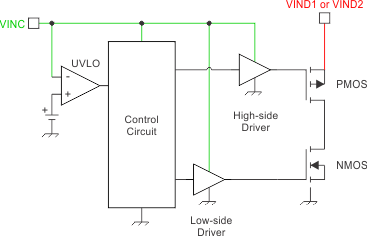SNVSB35C May 2018 – November 2024 LM26420-Q1
PRODUCTION DATA
- 1
- 1 Features
- 2 Applications
- 3 Description
- 4 Pin Configuration and Functions
- 5 Specifications
- 6 Detailed Description
-
7 Application and Implementation
- 7.1 Application Information
- 7.2 Typical Applications
- 7.3 Power Supply Recommendations
- 7.4 Layout
- 8 Device and Documentation Support
- 9 Revision History
- 10Mechanical, Packaging, and Orderable Information
7.3.1 Power Supply Recommendations - HTSSOP-20 Package
The LM26420-Q1 contains a high-side PMOS FET and a low-side NMOS FET for each channel, as shown in Figure 7-15. The source nodes of the high-side PMOS FETs are connected to VIND1 and VIND2, respectively. VINC is the power source for the high-side and low-side gate drivers. Ideally, VINC is connected to VIND1 and VIND2 by an RC filter as detailed in Section 7.1.2. If VINC is allowed to be lower than VIND1 or VIND2, the high-side PMOS FETs can be turned on regardless of the state of the respective gate drivers. Under this condition, shoot through occurs when the low-side NMOS FET is turned on and permanent damage can result. When applying input voltage to VINC, VIND1, and VIND2, VINC must not be less than VIND1,2 – VTH to avoid shoot through and FET damage.
 Figure 7-15 VINC, VIND1,
and VIND2 Connection
Figure 7-15 VINC, VIND1,
and VIND2 Connection